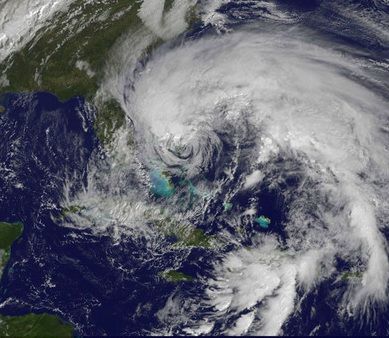HURRICANE SANDY MATH
scroll down to view / solve the math problems

PROBLEM SOLVING
An image taken from NOAA's GOES-13 satellite on Friday, Oct. 26 showed Hurricane Sandy's huge cloud extent of up to 2,000 miles while centered over the Bahamas, and the line of clouds associated with a powerful cold front approaching the U.S. east coast.
A). The data suggests the DIAMETER of Hurricane Sandy is 2000 miles. If we assume Sandy is a circle, what is the total area Sandy covers in terms of it's cloud extent? Write your final answer in both standard form and in scientific notation! Be sure to include the appropriate units to receive maximum credit! Show all work in your notebook but submit your answers using the form below!
On Oct. 27 NASA's TRMM satellite saw that rain
associated with Hurricane Sandy storm's center, was moderate and falling at a
rate of 20 to 40 mm per hour (1.57 inches per hour). The heaviest rainfall at
the time of the image was falling west of the center (and closest to the U.S.
East Coast) at a rate of more than 2 inches (50 mm) per hour.
B). The data suggests that the rain associated with Sandy was falling at an average rate of 30 mm per hour. If it were to rain for exactly 3 days straight, how much rain would have fallen in total? Express your answer as a unit rate in "mm per day." Show all work in your notebook but submit your answers using the form below!
SUBMIT YOUR ANSWERS HERE
References:
http://www.nasa.gov/mission_pages/hurricanes/archives/2012/h2012_Sandy.html
http://www.nhc.noaa.gov/
http://www.livescience.com/24338-hurricane-sandy-photos-frankenstorm.html



No comments:
Post a Comment